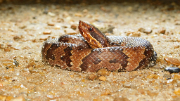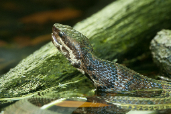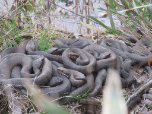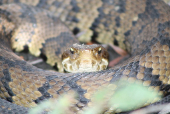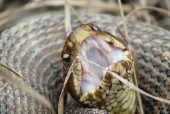
|
Cottonmouth (Agkistrodon piscivorus)
Description:The broad head is distinct from the neck, and the snout is blunt in profile with the rim of the top of the head extending forwards slightly further than the mouth. Substantial cranial plates are present, although the parietal plates are often fragmented, especially towards the rear. A loreal scale is absent. Six to 9 supralabials and eight to 12 infralabials are seen. At midbody, there are 23–27 rows of dorsal scales. All dorsal scale rows have keels, although those on the lowermost scale rows are weak. In males/females, the ventral scales number 130-145/128-144 and the subcaudals 38-54/36-50. Many of the latter may be divided.
Juvenile and subadult specimens generally have a more contrasting color pattern, with dark crossbands on a lighter ground color. The ground color is then tan, brown, or reddish brown. The tip of the tail is usually yellowish, becoming greenish yellow or greenish in subadults, and then black in adults. On some juveniles, the banding pattern can also be seen on the tail. Young snakes wiggle the tips of their tails to lure prey animals.
Habitat: Agkistrodon piscivorus is the most aquatic species of the genus Agkistrodon, and is usually associated with bodies of water, such as creeks, streams, marshes, swamps, and the shores of ponds and lakes. Its habits include lowland swamps, lakes, rivers, bayheads, sloughs, irrigation ditches, canals, rice fields, and small, clear, rocky, mountain streams. It is also found in brackish-water habitats and is sometimes seen swimming in salt water. It has been much more successful at colonizing Atlantic and Gulf coast barrier islands than the copperhead. However, even on these islands, it tends to favor freshwater marshes. A study describes it as not being particularly salt-tolerant. The snake is not limited to aquatic habitats, however, and large specimens have been found more than a mile from water. In various locations, the species is well-adapted to less moist environments, such as palmetto thickets, pine-palmetto forest, pine woods in East Texas, pine flatwoods in Florida, eastern deciduous dune forest, dune and beach areas, riparian forest, and prairies.
Range: This species is endemic to the United States. It range extends from southeastern Virginia (near junction of Appomattox and James rivers) to southern Florida, west to central Texas, Oklahoma, Arkansas, Missouri, and southeastern Kansas, and north in the middle Mississippi River drainage to southern Illinois.
Venom: Agkistrodon piscivorus venom is more toxic than that of A. contortrix, and is rich with powerful cytotoxic venom that destroys tissue. Although deaths are rare, the bite can leave scars, and on occasion, require amputation. Absent an anaphylactic reaction in a bitten individual, however, the venom does not cause systemic reactions in victims and does not contain neurotoxic components present in numerous rattlesnake species. Bites can be effectively treated with CroFab antivenom; this serum is derived using venom components from four species of American pit vipers (the eastern and western diamondback rattlesnakes, the Mojave rattlesnake, and the cottonmouth).
Symptoms commonly include ecchymosis and swelling. The pain is generally more severe than bites from the copperhead, but less so than those from rattlesnakes (Crotalus spp.). The formation of vesicles and bullae is less common than with rattlesnake bites, although necrosis can occur. Myokymia is sometimes reported. However, the venom has strong proteolytic activity that can lead to severe tissue destruction.
Diet: Its diet includes mammals, birds, amphibians, fish, eggs, insects, other snakes, small turtles, and small alligators. Cannibalism has also been reported. Normally, though, the bulk of its diet consists of fish and frogs.
Although fish and frogs are their most common prey, they eat almost any small vertebrate. Fish are captured by cornering them in shallow water, usually against the bank or under logs. They take advantage when bodies of water begin to dry up in the summer or early fall and gorge themselves on the resulting high concentrations of fish and tadpoles. They are surprisingly unsuccessful at seizing either live or dead fish under water. They are opportunistic feeders and sometimes eat carrion, making them one of the few snakes to do so.
Reproduction: Agkistrodon piscivorus is ovoviviparous, with females usually giving birth to one to 16 live young and possibly as many as 20. Litters of six to eight are the most common. Neonates are 22–35 cm in length (excluding runts). If weather conditions are favorable and food is readily available, growth is rapid and females may reproduce at less than three years of age and a total length of as little as 60 cm. They will also only reproduce every other year, unless optimal conditions are met for them to go through the reproduction process. The young are born in August or September, while mating may occur during any of the warmer months of the year, at least in certain parts of its range.
Status: Listed as Least Concern in view of its wide distribution, presumed large population, and because it is unlikely to be declining fast enough to qualify for listing in a more threatened category.
»» Kingdom: Animalia - Animals
»» Phylum: Chordata - Chordates
»» Subphylum: Vertebrata - Vertebrates
»» Class: Reptilia - Reptiles
»» Order: Squamata - Scaled Reptiles
»» Suborder: Serpentes
»» Clade: Colubroides
»» Family: Viperidae - Vipers
»» Genus: Agkistrodon
»» Species: Agkistrodon piscivorus - Cottonmouth
»» Subspecies: None
This article uses material from the Wikipedia article "Agkistrodon piscivorus", which is released under the Creative Commons Attribution-Share-Alike License 3.0. Content may have been omitted from the original, but no content has been changed or extended.
|
|



